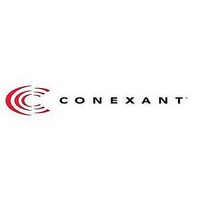cx28394 Conexant Systems, Inc., cx28394 Datasheet - Page 109

cx28394
Manufacturer Part Number
cx28394
Description
Quad/x16/octal-t1/e1/j1 Framers
Manufacturer
Conexant Systems, Inc.
Datasheet
1.CX28394.pdf
(305 pages)
- Current page: 109 of 305
- Download datasheet (3Mb)
CX28394/28395/28398
Quad/x16/Octal—T1/E1/J1 Framers
2.4.7 In-Band Loopback Code Generation
2.4.8 ZCS Encoder
100054E
BSLIP bits in the TERROR register. TCOFA commands a 1-bit shift in the
location of the transmit frame alignment by deleting (or inserting) a 1-bit position
from the transmit frame. During E1 modes, BSLIP determines which direction
the bit slip occurs. In T1 modes, only 1-bit deletion is provided. Note that TCOFA
alters extraction rate of data from transmit slip buffer; thus, repeated TCOFAs
eventually cause a controlled frame slip where one frame of data is repeated
(T1/BSLIP = 0), or where one frame of data is deleted (BSLIP = 1).
TBERR commands a single PRBS error by logically inverting the next PRBS
generator output bit.
register. TMERR commands a single Fs bit error in T1, or MFAS bit error in E1
by logically inverting the next multiframe bit transmitted.
TERROR register. TSERR commands a single MAS pattern error by logically
inverting the first MAS bit transmitted.
The in-band loopback code generator circuitry overwrites the transmit data with
in-band codes of configurable value and length. These codes are sequences with
periods of 1 to 7 bits and may, in some applications, overwrite the framing bit.
The Transmit Inband Loopback Code Configuration register [TLB; addr 077]
controls the functions required for this operation.
loopback code to the Transmit Inband Loopback Code Pattern register [LBP; addr
078], and then setting the Start Inband Loopback (LBSTART) and Loopback
Length (LB_LEN) bits in the Transmit Inband Loopback Code Configuration
register [TLB; addr 077]. The TLB register optionally allows the loopback code
to overwrite framing bits using the UNFRAMED bit. The LB_LEN provides
loopback code pattern lengths of 4 to 7 bits. Patterns of 2 or 3 bits can be achieved
by repeating the pattern in 4- or 6-bit modes, respectively. Framed or unframed all
ones or all zeros can also be achieved by setting the pattern to all zeros or all ones.
The ZCS encoder encodes the single rail clock and data (unipolar) into dual rail
data (bipolar). The Transmit Zero Code Suppression Bits (TZCS[1,0]) in the
Transmitter Configuration register [TCR1; addr 071] selects ZCS and Pulse
Density Violation (PDV) enforcement options for TPOSO/TNEGO output pins.
TZCS supports the following: Alternate Mark Inversion (AMI); High Density
Bipolar of order 3 (HDB3); Bipolar with 8 Zero Suppression (B8ZS); Pulse
Density Violation (PDV); Unassigned Mux Code (UMC); and Bipolar with 7
Zero Suppression (B7ZS). Note that ZCS encoding, which alters data content, is
performed prior to the CRC calculation so the outgoing CRC is always correct.
more than 15 consecutive zeros. A one is encoded as either a positive or negative
pulse; a zero is the absence of a pulse. Two consecutive pulses of the same
polarity are referred to as a Bipolar Violation (BPV).
Change Of Frame Alignments (COFAs) are controlled by the TCOFA and
PRBS test pattern errors are inserted by TBERR in the TERROR register.
Fs and MFAS errors are controlled by the TMERR bit in the TERROR
CAS Multiframe (MAS) errors are controlled by the TSERR bit in the
A loopback code is generated in the transmit data stream by writing the
The AMI line code requires at least 12.5 percent average ones density and no
Conexant
2.0 Circuit Description
2.4 Transmitter
2-51
Related parts for cx28394
Image
Part Number
Description
Manufacturer
Datasheet
Request
R

Part Number:
Description:
Bluetooth RF Transceiver
Manufacturer:
Conexant Systems, Inc.
Datasheet:

Part Number:
Description:
Bluetooth RF Transceiver
Manufacturer:
Conexant Systems, Inc.
Datasheet:

Part Number:
Description:
ATM transmitter/receiver with UTOPIA interface
Manufacturer:
Conexant Systems, Inc.
Datasheet:

Part Number:
Description:
Service SAR controller
Manufacturer:
Conexant Systems, Inc.
Datasheet:

Part Number:
Description:
CN8223EPFATM Transmitter/Receiver with UTOPIA Interface
Manufacturer:
Conexant Systems, Inc.
Datasheet:

Part Number:
Description:
Embedded modem family
Manufacturer:
Conexant Systems, Inc.
Datasheet:

Part Number:
Description:
Fully integrated T1/E1 framer and line interface
Manufacturer:
Conexant Systems, Inc.
Datasheet:

Part Number:
Description:
Flicker-free video encoder
Manufacturer:
Conexant Systems, Inc.
Datasheet:

Part Number:
Description:
Home Networking Physical Layer Device with Integrated Analog Front End Circuitry Data Sheet (Preliminary) CX82100-41Home Network Processor (HNP)
Manufacturer:
Conexant Systems, Inc.
Datasheet:

Part Number:
Description:
Manufacturer:
Conexant Systems, Inc.
Datasheet:

Part Number:
Description:
Manufacturer:
Conexant Systems, Inc.
Datasheet:

Part Number:
Description:
Manufacturer:
Conexant Systems, Inc.
Datasheet:

Part Number:
Description:
Flicker-free video encoder
Manufacturer:
Conexant Systems, Inc.
Datasheet:

Part Number:
Description:
SmartV.XX Modem
Manufacturer:
Conexant Systems, Inc.
Datasheet:

Part Number:
Description:
Multichannel synchronous communications controller
Manufacturer:
Conexant Systems, Inc.
Datasheet:










